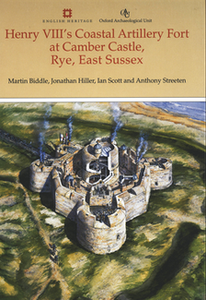English Heritage Archaeological Monographs
English Heritage, 2014. https://doi.org/10.5284/1028203. How to cite using this DOI
Data copyright © English Heritage unless otherwise stated
This work is licensed under the ADS Terms of Use and Access.
Primary contact
Historic England
The Engine House
Firefly Avenue
Swindon
SN2 2EH
Resource identifiers
- ADS Collection: 1416
- DOI:https://doi.org/10.5284/1028203
- How to cite using this DOI
Henry VIII's Coastal Artillery Fort at Camber Castle, Rye, East Sussex
Biddle, M., Scott, I., Hiller, J.
English Heritage (2001)
Abstract:

Camber Castle is located on the south coast of England, a short distance to the south of the town of and Cinque Port of Rye. Largely constructed between 1539 and 1543, it was an elaborate artillery fortification that represented an important element of Henry VIII's 'Device', or coastal defence network, put in place from 1539 as a response to the threat of invasion following England's breach with Rome. The castle was operational for 100 years. By the 1630s, the steady advance of the coastline had left it stranded well inland from the sea. This combined with changes in the concept of artillery fortification, resulted in its decommissioning in 1637. Unusually, Camber Castle was not adapted for continued use through the 18th and 19th centuries, and survives as an example of a largely unmodified Henrician artillery fort. It displays several clear and discrete phases of construction, which reflect changes in thinking about the design of fortifications. The construction phase of 1539-40, under the direction of Stephen von Haschenperg, is of particular interest since it represents the first attempt to build in England an artillery fortress of ultimately Italian inspiration. Doubts about the effectiveness of von Haschenperg's design led, however, to a complete remodelling of the castle's defences along more conservative lines, undertaken in 1542-3. The castle, which is in the guardianship of English Heritage, has seen numerous campaigns of research, survey and excavation. This volume draws together all the available evidence to provide a full and synthesised account of the current state of knowledge regarding this monument. It includes a revised and expanded version of Martin Biddle's authoritative study, originally published in The History of the King's Works. Full reports are also included on the artefact and animal bone assemblages, which are of considerable importance for the early post-medieval period. These include the extensive 16th- and early 17-century assemblage of English and imported pottery, a German ceramic tile-stove, a wide range of 16th- and 17th-century military artefacts, and a significant collection of vessel glass including facon de Venise cristallo. The animal bone collection is a useful benchmark for the zoo-archaeology of post-medieval England, and provides evidence for early livestock improvements. There is also a detailed review of the surviving building account for von Haschenperg's fortifications.
Download monograph
| Henry VIII's Coastal Artillery Fort at Camber Castle, Rye, East Sussex, Biddle, M.|Scott, I.|Hiller, J., English Heritage (2001), ISBN: 9781848021624 | 32 Mb |





